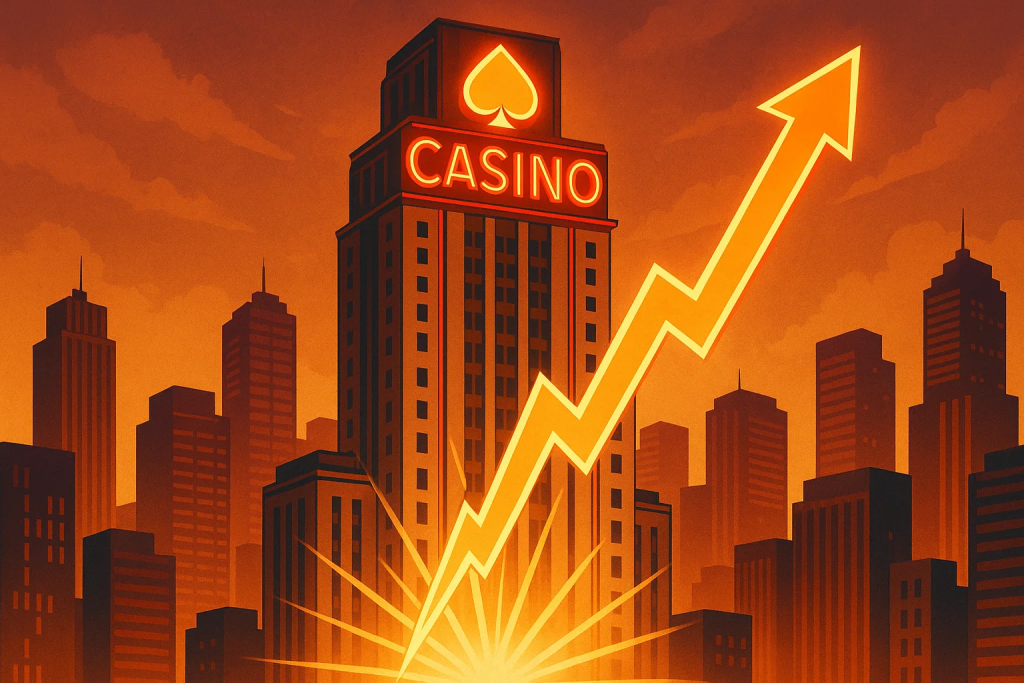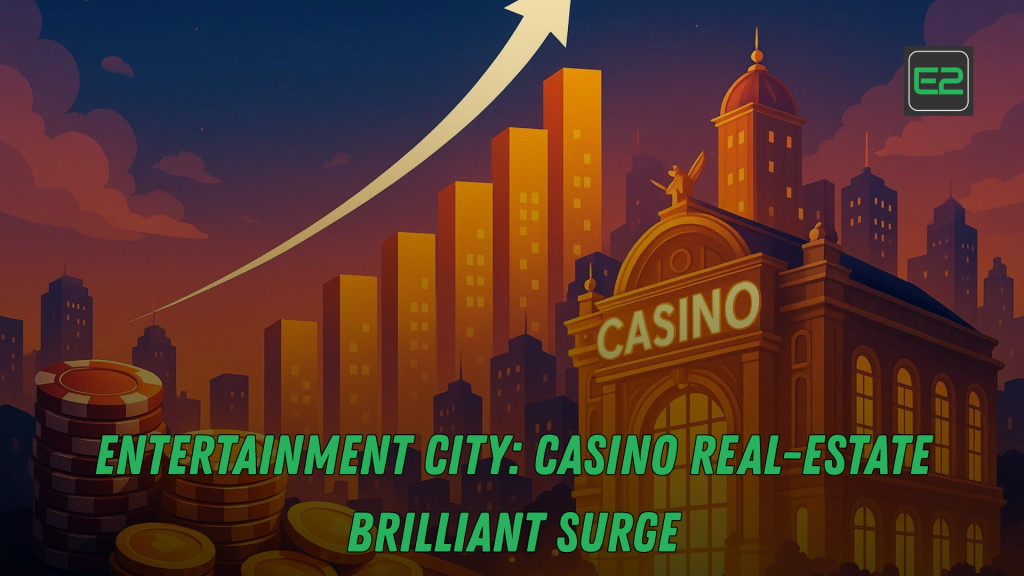Table of Contents
TL;DR (for busy readers)
Manila’s Entertainment City—the 8-km² government-planned integrated resort (IR) district on Manila Bay—has moved from vision to visible scale. With Solaire, City of Dreams, Okada operating and Westside City advancing toward completion (now tracking Q3 2026 after new funding), the IR-led real-estate flywheel—hotels, MICE, retail, residential and events—keeps accelerating. Strong gaming GGR growth in 2024–2025, improving airport and road connectivity (NAIAX), and fresh tourism policies (e.g., visa-free entry for Indian nationals) provide tailwinds. That said, investors should size construction and regulatory risk, tourism recovery gaps, and competition.

What (and where) is Entertainment City?
Entertainment City—also called E-City or Bagong Nayong Pilipino–Entertainment City—is a PAGCOR-led gaming and entertainment complex on reclaimed land in Bay City, Parañaque, south of the Mall of Asia and minutes from NAIA via the NAIA Expressway (NAIAX). It spans roughly 8 km² and was envisioned to cluster Las Vegas–style integrated resorts with shopping, dining, MICE, culture, and leisure.
Why that location works
- Airport proximity: Okada Manila cites a ~3 km distance to NAIA; NAIAX terminates at Entertainment City, shortening trips for international visitors.
- Bay Area clustering: Adjacent to Aseana City (107.5-ha masterplan by D.M. Wenceslao & Associates), enabling mixed-use spillovers—offices, retail, residential.
- Event capacity: The SMDC Festival Grounds opposite Solaire can host 50–55k attendees—fuel for concerts and tourism spikes that benefit hotels and F&B.
The Four-IR Spine: Operating Icons + The Next Big Thing
1) Solaire Resort & Casino (Bloomberry)
- First mover of Entertainment City (opened 2013), on 8.3 ha; two towers, upscale F&B, theatre, and a large gaming floor.
- Bloomberry has expanded its network with Solaire Resort North (Quezon City, opened May 25, 2024), signaling confidence in Metro Manila demand and broadening brand marketing reach for the Entertainment City flagship.
2) City of Dreams Manila (Melco / Belle)
- Opened 2014/2015; a major IR with hotels, gaming, dining, and family attractions. In 2025, Melco disclosed it was exploring a sale of its stake; media report DigiPlus as a leading contender—not yet finalized as of late September 2025. For investors, this is a watchlist item that could reshape capex, branding, and marketing synergies in the district.
3) Okada Manila (TRLEI / Universal Entertainment)
- The largest gaming floor in the Philippines, ~26,000 m², nearly 1,000 rooms, plus The Fountain and a vast nightlife/retail mix—anchoring the southern arc of the strip and consistently positioned as a premier IR close to NAIA.
4) Westside City (Suntrust / Travellers / Westside entities)
- The fourth IR in Entertainment City; scope includes a 475-key 5-star hotel, 3,000-seat performance hall, ballroom/MICE, and gaming floor of 281 tables + 1,100+ slots (developer figures). Timelines have shifted: earlier targets pointed to late 2025, but June–September 2025 updates cite Q3 2026, now backed by an additional $450M from partners to finish the project. This capex vote is pivotal for the district’s next up-cycle.
The Macro Story: Why Casino Real Estate is Surging
1) Velocity in Gaming Revenues (GGR)
PAGCOR projects PHP 450–480B GGR in 2025 after record 2024—with integrated resorts as a top driver. H1 2025 data show PHP 214.75B GGR, with IR casinos contributing PHP 93.36B (≈43%). This revenue base supports new hotel keys, retail leasing, and MICE expansion—vital for real-estate absorption.
2) Tourism Gradually Rebuilding (with policy nudges)
While the Philippines underperformed regional peers in 2024 and early 2025, policy shifts—e.g., visa-free entry for Indian nationals (from June 8, 2025)—aim to widen the funnel. The DOT logged ~2.9M international arrivals in H1 2025; the growth runway remains long relative to Thailand, Vietnam, and Singapore, but high-spend IR visitors help compensate.
3) Infrastructure that actually works for IRs
The NAIA Expressway (E6/NAIAX) directly connects Skyway ↔ NAIA ↔ Entertainment City, cutting friction for time-poor, high-value visitors—crucial in MICE bidding and VIP capture.
4) The Non-Gaming Multiplier: Events, Retail, and Aseana
- Events: SMDC Festival Grounds (50–55k capacity) brings touring festivals and K-pop/P-pop spectacles into the Bay Area on weekends—spillover rates for hotels can spike.
- Offices & mixed-use: The Aseana City pipeline keeps growing; DMW reported higher recurring revenues in 2024 and broke ground on Aseana Plaza in 2025. This steady work/live/play fabric increases weekday footfall beyond gaming.
- Hotel pipeline: Colliers flags Bay Area as a lead submarket for new rooms through 2027—critical for MICE competitiveness and rate power.
What This Means for Real Estate Stakeholders
Developers & Landlords
- Program for MICE: Design ballrooms with quick-change staging, divisible halls, and outdoor festival tie-ins. Westside City’s performance hall and ballroom specs are pointed directly at this demand.
- IR-adjacent retail: Emphasize late-night F&B, experiential stores, and wellness (spas, medical tourism) to convert leisure stays into repeat urban breaks.
- Brand stack: International flags + Filipino boutique brands balance rate power and local character.

Hotel Operators
- Compression windows: Align promotions with concerts at SMDC Grounds and major esports or boxing nights hosted in the Bay Area.
- Segment by traveler type: VIP, premium mass, MICE, families—each needs a distinct room-product + offer cadence.
Retailers & F&B
- Pre/post-show traffic: Offer festival menus, shuttle partnerships, and QR-based pre-orders timed to event ingress/egress.
- High-limit adjacency: Curate chef-led late seating near IR VIP entries; consider night brunch experiments for Asia-Pacific flyers arriving past 10 p.m.
Investor Lens: 7 Indicators to Track in 2025–2026
- Westside City construction and pre-opening milestones (capex drawdown, façade status, FF&E orders). Funding infusion of $450M in Sept 2025 is a key positive signal; guidance now Q3 2026.
- PAGCOR GGR monthly prints and mix (IR vs. e-games) to stress-test rent growth assumptions.
- DOT arrivals and policy updates (visa categories, air seats).
- Melco/City of Dreams stake sale outcomes and any re-branding capex or loyalty integrations that could shift market share in the strip.
- Aseana office and retail absorption (DMW disclosures, Colliers reports).
- Room-supply timing in Bay Area to anticipate ADR pressure or compression; Colliers tracks ~1,600 rooms/year through 2027 with Bay Area a major node.
- Regulatory tone (online gaming scrutiny; POGO wind-down already ordered in 2024) and responsible gaming moves by IRs—both can affect sentiment and ancillary demand.
Risks & Realities (and how to mitigate them)
- Construction delays & cost inflation. Westside City’s timeline moved from late-2025 targets to Q3 2026, underscoring supply-chain and review risks. Mitigation: lock long-lead imports early; use phased openings to monetize MICE and F&B ahead of full gaming launch.
- Tourism underperformance vs. ASEAN peers. 2024 arrivals missed targets; 2025 H1 pace is improving but still trails neighbors. Mitigation: package regional events, leverage visa-free corridors, and co-market with airlines.
- Policy/regulatory shifts. The 2024 POGO ban and ongoing scrutiny of e-gaming require active compliance. Mitigation: IRs’ joint statements on responsible gaming indicate an industry pivot to transparency—stay aligned.
- Supply cycles. As Bay Area keys and retail roll in, landlords must defend yield via differentiated concepts (wellness, fine-casual late-night, family edutainment).
Content & SEO Strategy (for operators, brokers, and media)
Core keyword cluster: Entertainment City Manila, casino real estate Philippines, Manila integrated resorts, Westside City casino, Solaire / Okada / City of Dreams, Bay Area Manila hotel.
Supporting intents: Aseana City offices, SMDC Festival Grounds events, NAIA Expressway access, PAGCOR GGR.
On-page playbook:
- Use H2/H3 for each IR and for macro drivers.
- Add stat boxes (GGR, room counts, opening dates).
- Insert internal links to investor updates, hotel offers, and events pages.
- Ship a FAQ schema block (see below) to win snippet real-estate.
- Keep captions and image alt text focused: “Okada Manila—largest gaming floor in PH; Entertainment City skyline.”
Mini-Maps & Quick Stat Boxes
Entertainment City at a glance
- Area: ~8 km² on Manila Bay, Parañaque
- IRs operating: Solaire (2013), City of Dreams (2014/2015), Okada (2016/2017)
- IR under construction: Westside City (funding reinforced; timeline Q3 2026)
- Access: NAIA Expressway on/off ramps to Entertainment City
- Event anchor: SMDC Festival Grounds (50–55k pax)
Gaming & Tourism signals (2024–2025)
- Record GGR 2024; 2025 projection PHP 450–480B (PAGCOR)
- H1 2025 GGR: PHP 214.75B; IRs: PHP 93.36B
- H1 2025 tourist arrivals: ~2.9M; visa-free entry launched for Indian nationals (June 8, 2025)
What Developers Can Build Next (Opportunity Matrix)
| Demand Driver | Real-Estate Response | Monetization Angle |
|---|---|---|
| Concert weekends (50–55k pax) | Adaptive F&B streets, festival-friendly logistics | Surge pricing + event bundles |
| MICE bid wars | Flexible ballrooms, translation booths, broadcast-ready rigs | Day-delegate packages; sponsor boxes |
| VIP & premium mass | Private lifts, discreet arrival lounges, wellness suites | High ADR suites + spa/medical add-ons |
| Family travel | Edutainment, indoor water play, safe night markets | Multi-room packages; loyalty uplifts |
| e-games growth | Esports lounges, streaming pods | Co-marketing with operators |
Case Study: Solaire North helps the Entertainment City “mothership”
Bloomberry’s Solaire North (Quezon City) doesn’t sit in Entertainment City—but it expands brand reach across Metro Manila, funnels new loyalty members, and creates city-wide itineraries (QC nights + Bay Area weekends). That brand scaffolding supports rate integrity and cross-property event weeks, benefiting the Bay Area asset base.

Strong Call-to-Action (CTA)
Are you planning, investing in, or marketing real estate in Entertainment City?
Tell me your asset type (hotel, retail, office, mixed-use), opening window, and target market. I’ll reply with a three-step content & leasing plan (keyword map + event hooks + partner list) tailored to your project—and a 30-day editorial calendar to capture GGR and event surges.
Final word: Entertainment City’s casino real-estate surge is real—and broad-based. If you match the right product (MICE-ready hotels, festival-friendly retail, family edutainment) with peak events, airport proximity, and responsible-gaming alignment, you can ride the next multi-year growth wave of Manila’s Bay Area.
Manila’s Entertainment City—the PAGCOR-planned integrated resort (IR) district on Manila Bay—has shifted from vision to a mature, fast-scaling ecosystem. Its momentum rests on four pillars: (1) operating IRs (Solaire, City of Dreams, Okada), (2) the next build (Westside City), (3) location + infrastructure (NAIA Expressway access, Bay Area clustering), and (4) supportive demand signals (record gaming revenues, recovering tourism, large-scale events). Together, these drivers are catalyzing new hotel keys, MICE capacity, retail/F&B concepts, and IR-adjacent mixed use across the Bay Area.
Where and why it works. The district sits on reclaimed land in Parañaque, minutes from NAIA via NAIAX, reducing friction for time-poor, high-value visitors and event delegates. It benefits from adjacency to Aseana City, an expanding live-work-play masterplan that brings weekday footfall (offices, residential, schools) to complement weekend leisure demand. Across the road, SMDC Festival Grounds (≈50–55k capacity) injects concert and festival audiences that spike hotel occupancy and late-night F&B sales.
Cebu’s Nustar Debuts Brilliant High-Stakes Baccarat Rooms
The IR spine.
- Solaire Resort & Casino (opened 2013) anchored the district and, together with Solaire Resort North in Quezon City (opened 2024), extends brand reach and loyalty funnels back to the Bay.
- City of Dreams Manila (2014/15) remains a major node; potential changes in ownership are a watch-item for branding, capex and loyalty synergies.
- Okada Manila (2016/17) boasts the country’s largest gaming floor, ~1,000 rooms, and headline attractions, reinforcing the area’s upscale positioning.
- Westside City is the fourth IR under construction, with a 5-star hotel, performance hall, ballroom/MICE, and a sizable gaming floor. After timeline slippage, guidance now targets Q3 2026, underpinned by a fresh $450M capital infusion—crucial for the district’s next demand leg.
Demand tailwinds. PAGCOR logged a record GGR in 2024 and projects PHP 450–480B for 2025; H1 2025 GGR reached PHP 214.75B with IRs contributing ~PHP 93.36B. Tourism is rebuilding; visa-free entry for Indian nationals (from mid-2025) and ~2.9M international arrivals in H1 2025 widen the funnel, even if the Philippines still trails some ASEAN peers. The Bay Area’s hotel pipeline (flagged by market watchers through 2027) is timed to catch compression windows from concerts, conventions and sports/esports weekends.
Implications by stakeholder.
- Developers/Landlords: Program for MICE and festivals (divisible ballrooms, quick-change staging, outdoor-ready logistics). Curate late-night F&B, experiential retail, wellness/medical offerings, and family edutainment to lift non-gaming revenue.
- Hotels: Segment products and offers by VIP, premium mass, MICE, families; time promotions to SMDC Grounds calendars and major fight/esports nights.
- Retail/F&B: Monetize pre/post-show surges with event menus, QR pre-orders, shuttle tie-ups; test late-seating “night brunch” for late arrivals.
Investor watchlist (2025–2026). Track Westside City construction milestones; monthly GGR mix (IR vs. e-games); DOT arrivals and air capacity; any City of Dreams ownership outcome; Aseana office/retail absorption; Bay Area room-supply timing (ADR pressure vs. compression); regulatory tone (e-gaming scrutiny, responsible-gaming initiatives). These indicators shape rental growth assumptions, opening windows and underwriting.
Risks and mitigations.
- Construction slippage/costs: lock long-lead imports; consider phased opening (MICE/F&B first).
- Tourism underperformance: co-market with airlines, build regional event packages, leverage visa corridors.
- Policy shifts: maintain strict compliance, proactive responsible-gaming communication, and diversified non-gaming demand.
- Supply cycles: defend yields with differentiated concepts (wellness, chef-led late night, family attractions).
Bottom line. Entertainment City’s surge is broad-based: airport-close IRs, event-led footfall, rising GGR, and a strengthening mixed-use fabric. Stakeholders who align product-market fit (MICE-ready hotels, festival-friendly retail, premium dining, family edutainment) with peak event calendars, seamless access, and transparent compliance are positioned to ride Manila Bay’s next multi-year upswing in casino real estate.
Frequently Asked Questions (FAQ)
1) Which integrated resorts are operating today in Entertainment City?
2) When will Westside City open?
3) How strong is the market backdrop for IR real estate?
4) What’s happening at City of Dreams Manila ownership-wise?
Sources & Notes
- District background, area, and timeline: Entertainment City overview.
- IR specifics and openings: Solaire, Okada, City of Dreams official/summary pages.
- Westside City funding + timeline: Inquirer, Philstar, World Casino Directory, and Yogonet/iGamingBusiness updates.
- GGR & tourism: Reuters/PAGCOR/GMA/PNA; visa-free India policy via Reuters.
- Connectivity & events: NAIAX; SMDC Festival Grounds capacity.
- Aseana City developer disclosures and new offices: DMW reports and news.
